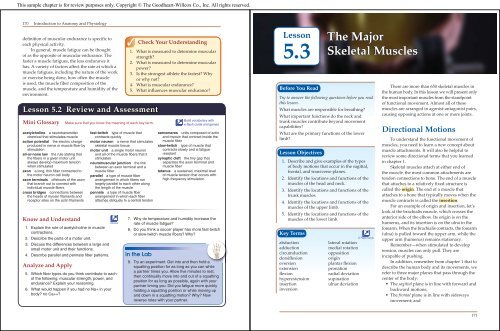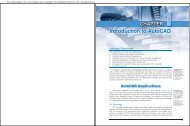You also want an ePaper? Increase the reach of your titles
YUMPU automatically turns print PDFs into web optimized ePapers that Google loves.
This sample chapter is for review purposes only. Copyright © The <strong>Goodheart</strong>-<strong>Willcox</strong> Co., Inc. All rights reserved.<br />
170 Introduction to Anatomy and Physiology<br />
defi nition of muscular endurance is specifi c to<br />
each physical activity.<br />
In general, muscle fatigue can be thought<br />
of as the opposite of muscular endurance. The<br />
faster a muscle fatigues, the less endurance it<br />
has. A variety of factors affect the rate at which a<br />
muscle fatigues, including the nature of the work<br />
or exercise being done, how often the muscle<br />
is used, the muscle fi ber composition of the<br />
muscle, and the temperature and humidity of the<br />
environment.<br />
Lesson 5.2 Review and Assessment<br />
Mini Glossary Make sure that you know the meaning of each key term.<br />
acetylch oline a neurotransmitter<br />
chemical that stimulates muscle<br />
action pote ntial the electric charge<br />
produced in nerve or muscle fi ber by<br />
stimulation<br />
all-or-non e law the rule stating that<br />
the fi bers in a given motor unit<br />
always develop maximum tension<br />
when stimulated<br />
axon a long, thin fi ber connected to<br />
the motor neuron cell body<br />
axon term inals offshoots of the axon<br />
that branch out to connect with<br />
individual muscle fi bers<br />
cross br idges connections between<br />
the heads of myosin fi laments and<br />
receptor sites on the actin fi laments<br />
Know and Understand<br />
1. Explain the role of acetylcholine in muscle<br />
contractions.<br />
2. Describe the parts of a motor unit.<br />
3. Discuss the differences between a large and<br />
small motor unit and their functions.<br />
4. Describe parallel and pennate fi ber patterns.<br />
Analyze and Apply<br />
5. Which fi ber types do you think contribute to each<br />
of the following: muscular strength, power, and<br />
endurance? Explain your reasoning.<br />
6. What would happen if you had no Na+ in your<br />
body? no Ca++?<br />
fast-t witch type of muscle that<br />
contracts quickly<br />
motor n euron a nerve that stimulates<br />
skeletal muscle tissue<br />
motor unit a single motor neuron<br />
and all of the muscle fi bers that it<br />
stimulates<br />
neuromuscular jun ction the link<br />
between an axon terminal and a<br />
muscle fi ber<br />
par allel a type of muscle fi ber<br />
arrangement in which fi bers run<br />
largely parallel to each other along<br />
the length of the muscle<br />
pe nnate a type of muscle fi ber<br />
arrangement in which each fi ber<br />
attaches obliquely to a central tendon<br />
Assess<br />
Check Your Understanding<br />
1. What is measured to determine muscular<br />
strength?<br />
2. What is measured to determine muscular<br />
power?<br />
3. Is the strongest athlete the fastest? Why<br />
or why not?<br />
4. What is muscular endurance?<br />
5. What infl uences muscular endurance?<br />
sarco meres units composed of actin<br />
and myosin that contract inside the<br />
muscle fi ber<br />
slow-t witch type of muscle that<br />
contracts slowly and is fatigue<br />
resistant<br />
synaptic cleft the tiny gap that<br />
separates the axon terminal and<br />
muscle fi ber<br />
te tanus a sustained, maximal level<br />
of muscle tension that occurs with<br />
high-frequency stimulation<br />
7. Why do temperature and humidity increase the<br />
rate of muscle fatigue?<br />
8. Do you think a soccer player has more fast-twitch<br />
or slow-twitch muscle fi bers? Why?<br />
In the Lab<br />
Build vocabulary with<br />
e-fl ash cards and games<br />
9. Try an experiment. Get into and then hold d a<br />
squatting position for as long as you can while<br />
a partner times you. Allow fi ve minutes to rest;<br />
then continually move into and out of a squatting<br />
position for as long as possible, again with your<br />
partner timing you. Did you fatigue more quickly<br />
holding a squatting position or while moving up<br />
and down in a squatting motion? Why? Now<br />
reverse roles with your partner.<br />
Lesson<br />
5.3<br />
Before You Read<br />
The Major Major<br />
Skeletal Muscles<br />
Try to answer the following questions before you read<br />
this lesson.<br />
What muscles are responsible for breathing?<br />
What important functions do the neck and<br />
trunk muscles contribute beyond movement<br />
capabilities?<br />
What are the primary functions of the lower<br />
limb?<br />
Lesson Objectives<br />
1. Describe and give examples of the types<br />
of body motions that occur in the sagittal,<br />
frontal, and transverse planes.<br />
2. Identify the locations and functions of the<br />
muscles of the head and neck.<br />
3. Identify the locations and functions of the<br />
trunk muscles.<br />
4. Identify the locations and functions of the<br />
muscles of the upper limb.<br />
5. Identify the locations and functions of the<br />
muscles of the lower limb.<br />
Key Terms<br />
abduction<br />
adduction<br />
circumduction<br />
dorsifl exion<br />
eversion<br />
extension<br />
fl exion<br />
hyperextension<br />
insertion<br />
inversion<br />
E-Flash Cards<br />
lateral rotation<br />
medial rotation<br />
opposition<br />
origin<br />
plantar fl exion<br />
pronation<br />
radial deviation<br />
supination<br />
ulnar deviation<br />
There are more than 650 skeletal muscles in<br />
the human body. In this lesson we will present only<br />
the most important muscles from the standpoint<br />
of functional movement. Almost all of these<br />
muscles are arranged in agonist-antagonist pairs,<br />
causing opposing actions at one or more joints.<br />
Directional Motions<br />
To understand the functional movement of<br />
muscles, you need to learn a new concept about<br />
muscle attachments. It will also be helpful to<br />
review some directional terms that you learned<br />
in chapter 1.<br />
Skeletal muscles attach at either end of<br />
the muscle; the most common attachments are<br />
tendon connections to bone. The end of a muscle<br />
that attaches to a relatively fi xed structure is<br />
called the origin. The end of a muscle that<br />
attaches to a bone that typically moves when the<br />
muscle contracts is called the insertion.<br />
For an example of origin and insertion, let’s<br />
look at the brachialis muscle, which crosses the<br />
anterior side of the elbow. Its origin is on the<br />
humerus, and its insertion is on the ulna in the<br />
forearm. When the brachialis contracts, the forearm<br />
(ulna) is pulled toward the upper arm, while the<br />
upper arm (humerus) remains stationary.<br />
Remember—when stimulated to develop<br />
tension, muscles can only pull. They are<br />
incapable of pushing.<br />
In addition, remember from chapter 1 that to<br />
describe the human body and its movements, we<br />
refer to three major planes that pass through the<br />
center of the body:<br />
• The sagittal plane is in line with forward and<br />
backward motions;<br />
• The frontal plane is in line with sideways<br />
movement; and<br />
171

















